One can hardly pick up a newspaper today, watch a television news program or read an online news service without encountering a number of stories about large, complex problems affecting part or all of the earth's population. From disease pandemics to hunger, civil strife, educational needs, pollution and global warming, among others, there are a host of issues that vie for attention and demand resources. However, as we all know, those resources are limited, which suggests the question: How best to allocate limited resources to return the highest benefit?
For some, this type of benefit/cost question may seem inappropriate for these sorts of problems, especially when we are talking about life-and-death issues. How can we possibly decide that people whose lives are plagued by hunger are more or less worth helping than those who are faced with a life-threatening disease? But the fact is, we have to decide because we can't aid every afflicted person or solve every problem—at least not at the same time. We have to prioritize.
That's where economics comes in. As Nancy Stokey explains in the 2005 Annual Report essay, economics can help us answer these questions because it offers an analytical tool—benefit/cost analysis—that helps people make choices about these very important matters. It's not perfect, but it's a tool for helping to refine choice. "Benefit/cost analysis ... organizes the quantitative evidence within a systematic framework," Nancy writes. "Even if the final B/C ratio does not tell the whole story, the assumptions used to construct that ratio must be made explicit, the omissions and short-cuts are exposed, and the issues being left out can be identified and discussed in parallel with the quantitative analysis."
As you will learn from the essay, Nancy was part of a select group of economists—the Copenhagen Consensus—called together to determine how $50 billion could best be spent to address the world's most demanding problems. Readers will gain insight not only into those issues, but also into how economists go about analyzing such seemingly intractable problems. Nancy has served as a consultant to the Minneapolis Fed in recent years, and we have benefited from her insights and contributions to our work here at the bank; I am pleased that you will also benefit from her thoughtful analysis and clear presentation of the choices that were put before her group—and before all of us.
Gary H. Stern
President
Annual Report Essay: Giving Aid Effectively




